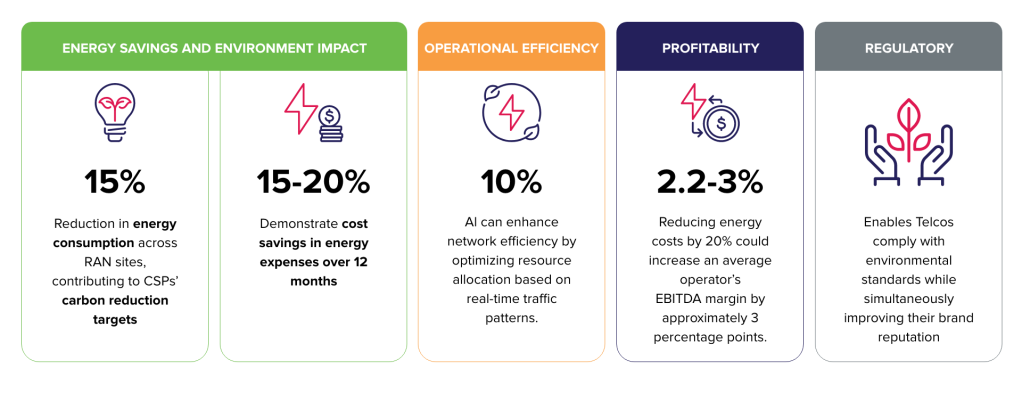Unveiling AI-Powered RAN Optimization & Network Intelligence at DTW Ignite 2025
The telecom industry is at an inflection point—where automation, sustainability, and network intelligence have become business-critical. As 5G scales and networks grow increasingly dense and complex, Communications Service Providers (CSPs) face mounting pressure to reduce energy consumption, lower costs, and modernize operations.
At DTW Ignite 2025, Sutherland, Snowflake, TM Forum, Tupl, and Zinkworks will showcase a breakthrough TM Forum Catalyst Project that delivers intelligent, AI-led solutions for RAN energy optimization and predictive fault management.
The Challenge: High Energy Costs, Manual Operations & Network Complexity
The telecom industry is evolving faster than ever, but CSPs are struggling with three major operational challenges.
With these challenges in mind, the future of telecom depends on AI-powered automation, predictive analytics, and intelligent energy management.
Skyrocketing Energy Consumption
Manual & Inefficient Troubleshooting
Scaling 5G Requires Smarter Operations
The Solution: AI-Led Energy Optimization & Predictive Operations
Sutherland and its partners are delivering an AI-powered, end-to-end solution that transforms both traditional and Open RAN environments:
Smart RAN Energy Management
Our AI-powered energy management solution is designed to:
✔ Reduces energy consumption by up to 25%.
✔ Cuts carbon emissions by up to 20%.
✔ Dynamically adjusts power usage using real-time traffic and environmental data.

Predictive Fault Management
✔ Forecasts and prevents failures up to 24 hours in advance.
✔ Automates incident detection and reduces downtime.
✔ Improves customer experience and SLA compliance.

A Collaboration That Drives Transformation
This Catalyst is a joint innovation between:
Sutherland – Lead orchestrator, providing the SMO, RAN simulation, and AI-driven automation models.
Snowflake – Cloud-native data mediation and analytics backbone.
Tupl – Provider of the Power Saving Advisor for legacy RAN energy optimization.
Zinkworks – Developer of the Open RAN rApp for intelligent energy control.
TM Forum – Framework and governance provider, facilitating industry-wide alignment via Open APIs and ODA.
Champion CSPs include: Verizon, Axian, Dhiraagu, and GCI, validating the solution across diverse geographies and regulatory frameworks.

Measuring Success
As CSPs embark on the journey toward AI-powered network automation, measuring success and tracking results over time is essential.
Our phased approach ensures continuous improvements, with tangible benefits at each stage:
Short-Term (6-12 Months)
Early-stage energy savings become visible within the first 6 months, providing an immediate return on investment.
Medium-Term (12-24 Months)
By month 18, CSPs experience full-scale energy optimization, with significant enhancements in operational efficiency, customer experience, and sustainability impact.
Future Roadmap & Scalability
Once successfully implemented, this solution can be scaled beyond the RAN to optimize core and edge network layers, expanding the impact of AI-driven predictive analytics and automation across the entire network stack.

By adopting this roadmap, CSPs can accelerate their transition toward autonomous networks, ensuring sustained efficiency, cost savings, and resilience in an increasingly complex telecom landscape.
Sustainable 5G: Smart RAN Energy Management
Join Us at DTW Ignite, Copenhagen and Experience It Firsthand!
TM Forum Catalyst Project C25.0.783
Sutherland is proud to co-lead this TM Forum Catalyst, showcasing how AI-driven orchestration can dramatically reduce RAN energy consumption.
When: 5:10 PM CEST, June 18, 2025
Where: Innovation Arena Stage
In addition, meet our team at the AI & Data Innovation Zone – Kiosk i 3.13 to explore the tech behind the Catalyst.

Why It Matters
As the industry moves toward autonomous, zero-touch networks, the ability to predict, optimize, and automate operations is critical. This Catalyst showcases how CSPs can:
- Lower OPEX by reducing manual interventions and energy use.
- Increase uptime and service resilience.
- Advance ESG goals with a measurable reduction in carbon impact.















